The striped hyena (Hyaena hyaena) prefers going solo. This nocturnal scavenger spends a large part of the day resting in bushes, dens, or under cover of tall grass, but as night falls, it sneaks out to look for a meal. Though it has weak eyesight, its long, pointed ears help it navigate the dark. Its striped fur blends in with grasses as it travels alone and unnoticed. However, there’s one occasion when a hyena clan comes together — to guard newborn cubs.
“Historically, the striped hyena has shared its habitat with formidable predators such as tigers, lions, and leopards. Over generations, it evolved to invest time and energy in protecting its offspring,” says Dr IP Bopanna, landscape coordinator, WWF India, who studied the species in Kutch for eight years for his doctoral thesis. “During my fieldwork, I noticed the moment a mother has cubs, a clan starts forming around the den — the mother, her siblings, her first litter, all gather every evening to play with and care for the cubs,” he says. While the father remains absent from the action, the rest of the clan not only congregates, but older siblings and adults bring back bones and bits of carcasses for the young and split the responsibility of caring for them with the mother.
Today, in several parts of Western India, especially Velavadar and Kutch, Gujarat, where the reign of wild cats has weakened, the striped hyena is the largest carnivore. In these regions, the cultural practice of haddakuddi, where livestock herders pile carcasses on the periphery of the village for scavengers, provides easy meals for the hyenas. This leaves them with enough time to raise young ones and offers researchers like Dr Bopanna a rare insight into a poorly studied creature’s kinship and social behaviour. As a result, we get to see the tender side of an otherwise maligned and misunderstood creature.
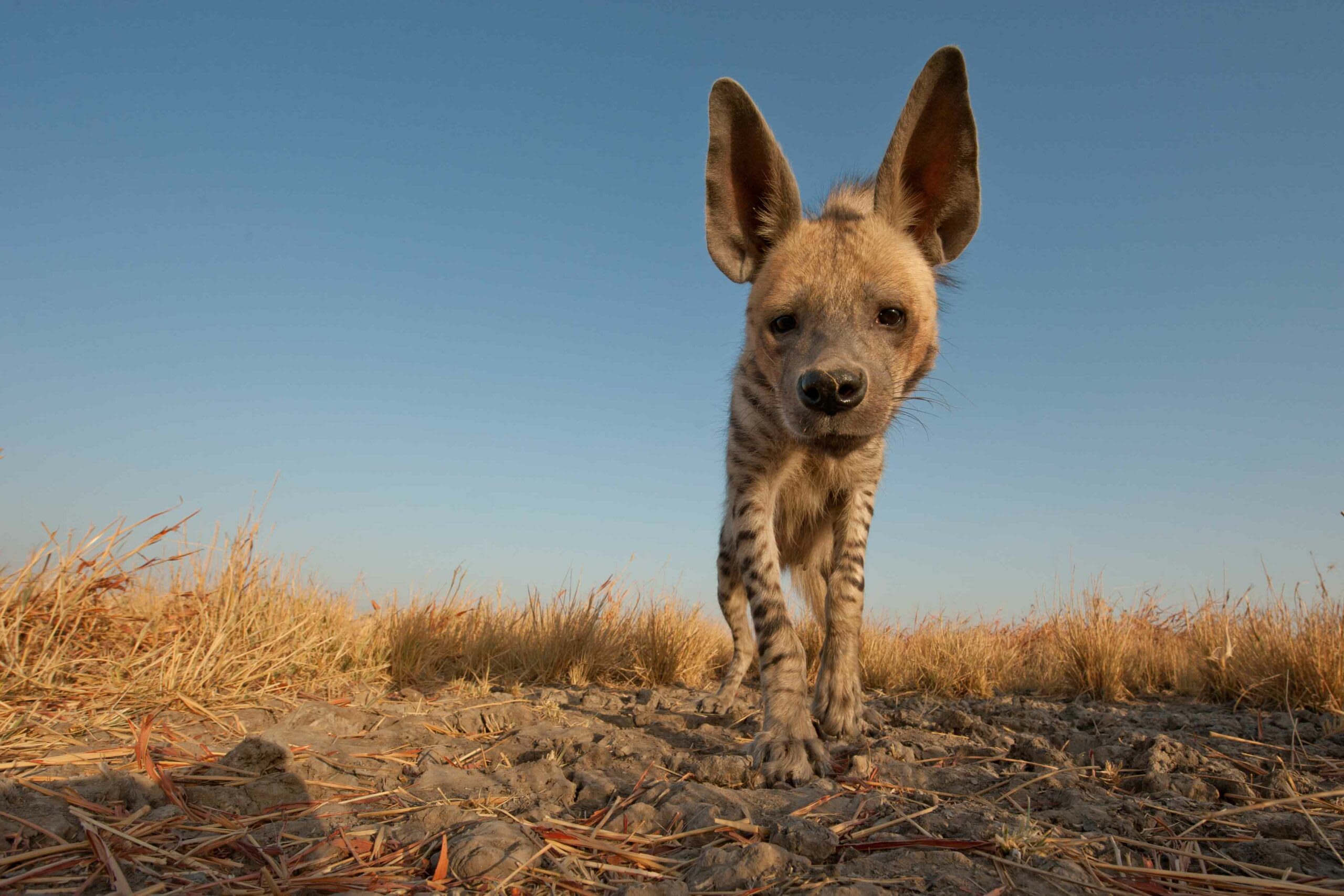
Four species of hyenas are found around the world — spotted, striped, brown and aardwolf. Unlike the more gregarious spotted hyenas that live and hunt in clans, the striped hyena is a solitary scavenger that occasionally preys on medium- to small-sized prey. Photo: Kalyan Varma Cover photo: Kalyan Varma
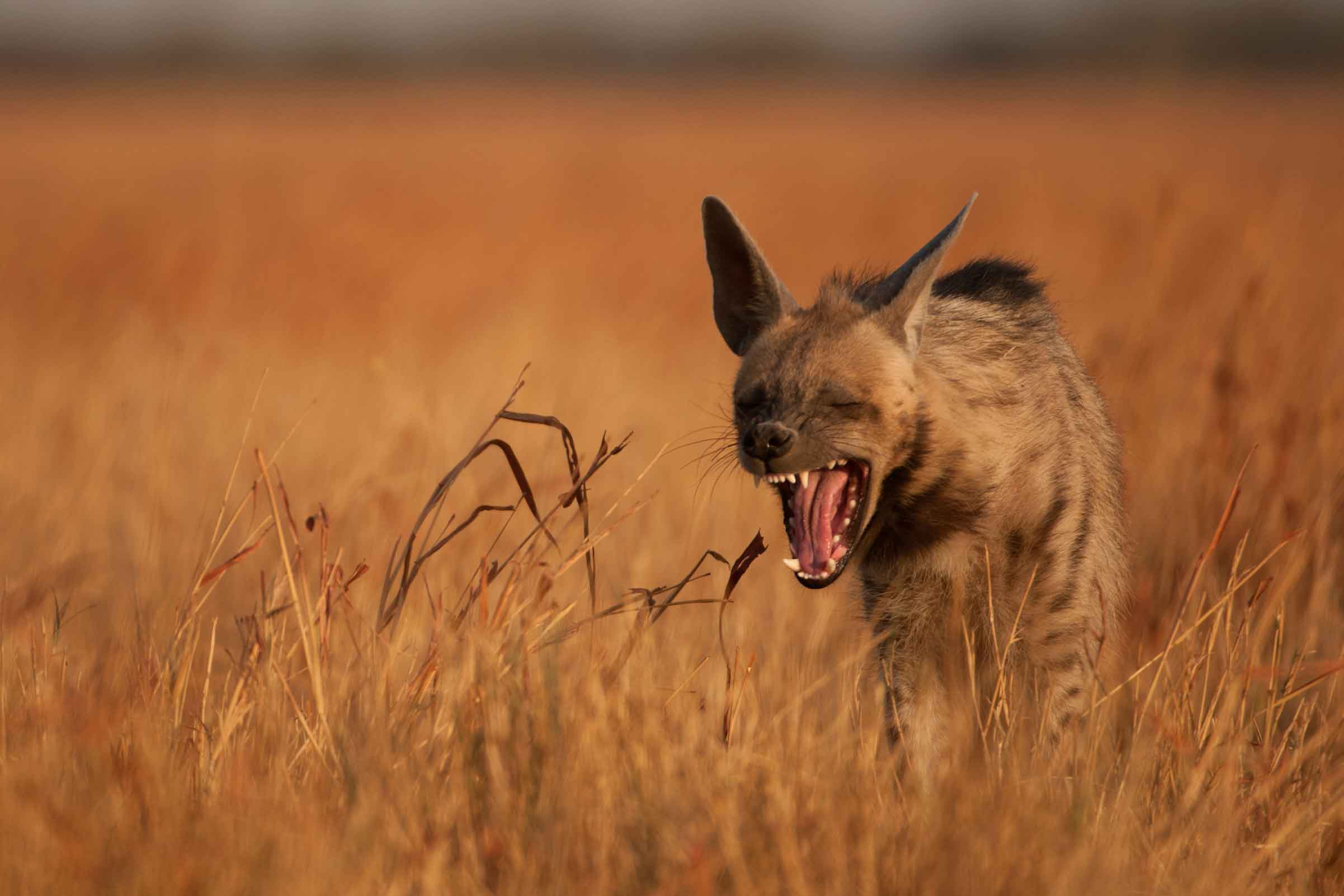
Its powerful jaw, large teeth, and strong skull have evolved to crush bones, while its specially evolved stomach acids are equipped to digest just about anything. Hair, horns, nails — everything is fair game. In some parts of the world, studies have recorded striped hyenas digging human graves and carrying away bones. In India, they’re known to feed on anything from other hyena carcasses to cucumbers. Photo: Kalyan Varma

Dens become the heart of a striped hyena’s universe during the breeding season. “They are activity centres that govern a hyena’s movement in a landscape,” says Dr Bopanna. The female finds an ideal location with great access to food and water before giving birth to her litter. Here, she might dig a fresh den or expand a burrow created by foxes, monitor lizards, or even porcupines. As the cubs grow, they excavate further to create cosy, comfortable enclosures. New or “simple” dens (above) have fewer entrances, but prized locations are prime real estate. Multiple mothers, offspring, and subadults can reside in an area creating a complex network of tunnel-like dens with multiple entrances. Photo: Mihir Godbole

Mihir Godbole, filmmaker and founder of The Grasslands Trust, spotted this extended family of striped hyenas near Jejuri in Maharashtra. It lived around a set of complex dens with entrances that went around the hill. “I have seen dens that are several metres long and form a network that can spread across almost half a kilometre,” he says. “They not only host hyenas and their cubs, but also porcupines, monitor lizards, and other creatures.” Photo: Mihir Godbole

Hyena dens are secure abodes for cubs, but they also function as storage units to “cache” leftovers. A striped hyena scavenges on carcasses and carries the surplus back to its den site — either to feed on during a leaner period, as treats for cubs, or simply as leftovers for others. Photo: Vipul Ramanuj
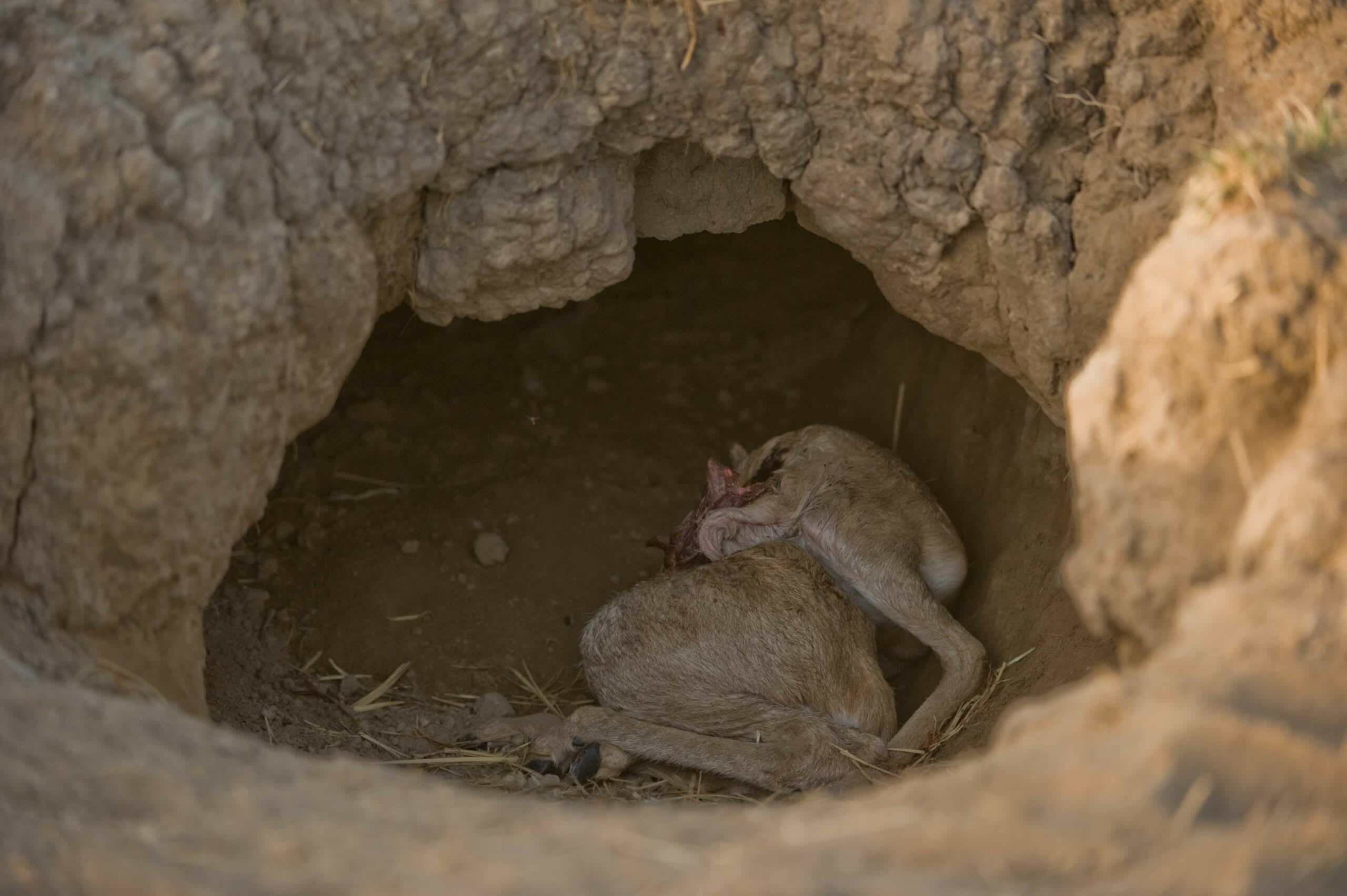
Bones of all shapes and sizes usually surround an active den. In Velavadar, Gujarat, wildlife photographer Kalyan Verma noticed a den with the carcass of a blackbuck fawn neatly tucked away. He reckons the fawn was hunted by a striped hyena and saved for the cubs to consume. In 2021, archaeologists in northwestern Saudi Arabia unearthed hundreds of thousands of bones, accumulated by striped hyenas, in a sprawling network of tunnels formed by volcanic activity. Radiocarbon dating suggests that some bones were over 6,000 years old. Interestingly, during his study in Kutch, Dr Bopanna noticed that the number of bones found at an active den site went up when the cubs were young — and the cubs’ older siblings had much to do with it. Photo: Kalyan Varma
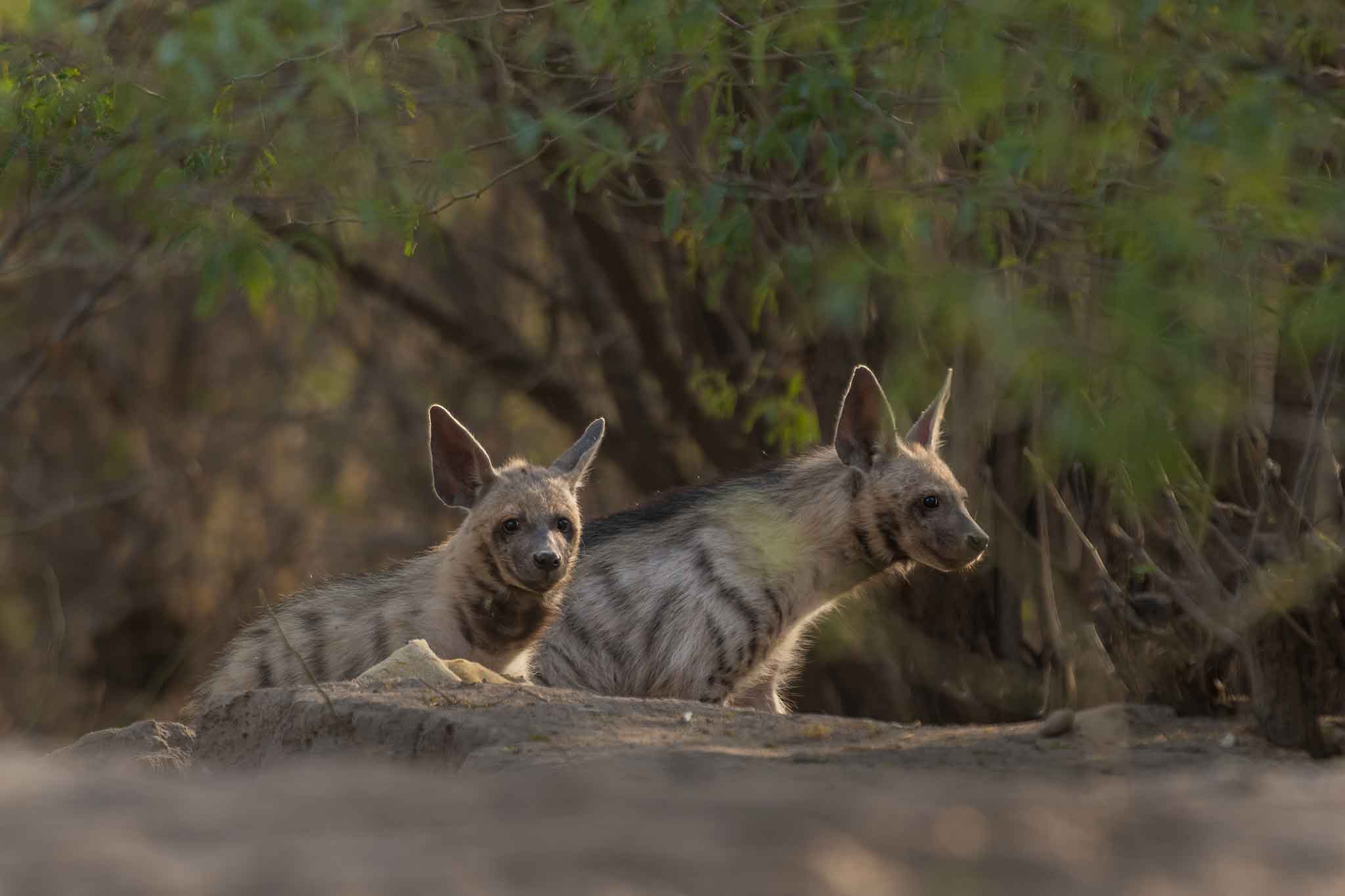
Older siblings or subadult hyenas (male and female) are key clan members. They play an important role in bringing food back to the den for the young litter. “Every evening, I’d see the subadults gather around the den to play with the litter — sometimes they’d bring food, sometimes they’d simply stand guard along the dens,” says Dr Bopanna. “As the sun went down, the subadults slowly dispersed on their own to forage.” The coming together of the clan creates an efficient system that ensures the safety of the youngest litter. It also eases some of the pressure off the lactating mother. In Kutch, Bopanna documented a case where the accidental death of siblings in a clan led to the death of all three cubs, illustrating the importance of their role. Photo: Vipul Ramanuj
The female striped hyena is a devoted mother. The father has not been observed playing an active role in raising the cubs. He often leaves the den site as soon as the cubs are born. The cubs open their eyes for the first time about a week after they are born and start walking and growing teeth at two weeks. During this vulnerable time, the mother is most attentive and spends a lot of time grooming and licking the cubs. She also keeps an eye out for threats. Caches of bones and carcasses can attract village dogs, jackals, and other scavengers. The rotting remains also breed parasites. To keep her cubs safe, the mother moves her offspring often during the rearing period. “I have recorded a mother move twenty-two times during a short period of six months!” says Dr Bopanna. Photos: Kalyan Varma

Kalyan Varma, photographer and wildlife filmmaker, saw this mother and her litter between 2012 and 2013 in Velavadar, Gujarat. Hyenas are nocturnal and secretive and not easy to photograph, yet this female was bold and came out of her den to rest in the evenings barely 20 metres from the road, he says during a telephone interview. “Hyenas don’t usually have a favourable perception, but there was much grace and tenderness in her conduct with her cubs,” says Varma. Photo: Kalyan Varma
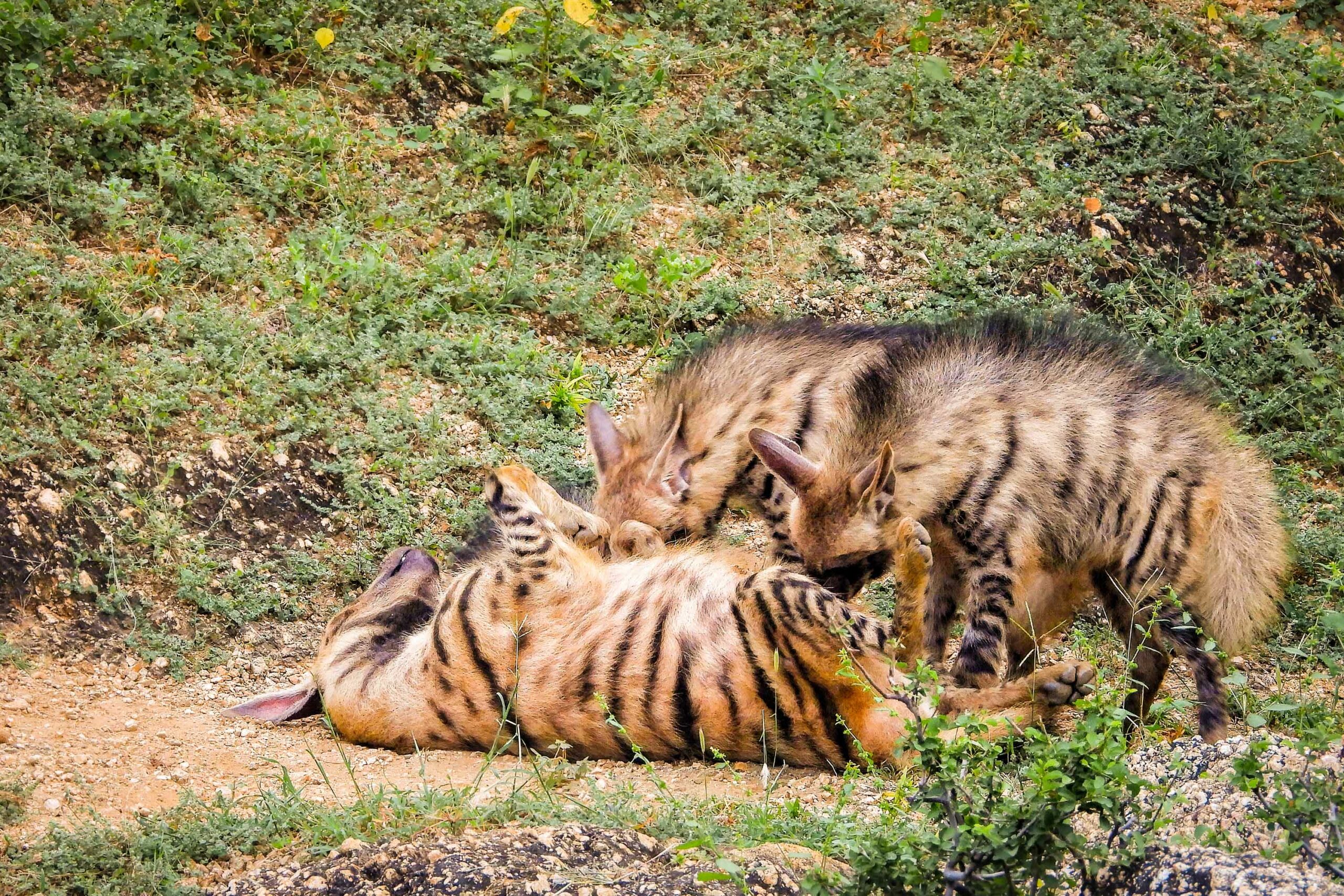
Mothers suckle their young for 4-5 months. Their extensive intake of bones ensures the cubs get a healthy dose of calcium. Over 6-8 months, as the young ones grow, the clan slowly disperses, only to reunite for the next breeding season. This time, the previous season’s litter takes charge. Photo: Bheru Bishnoi

The striped hyena is found mostly in dry, arid regions in India. Its range lies largely outside “protected areas”. Unfortunately, habitat loss, especially through quarrying and mining, disturbs and destroys den sites. A rising population of free-ranging dogs has emerged as a new threat to hyenas, bringing diseases like rabies to them. As a scavenger, striped hyenas keep landscapes clear of rotting carcasses and curbs the spread of disease. However, their habitats need urgent conservation attention. Photo: Kalyan Varma
